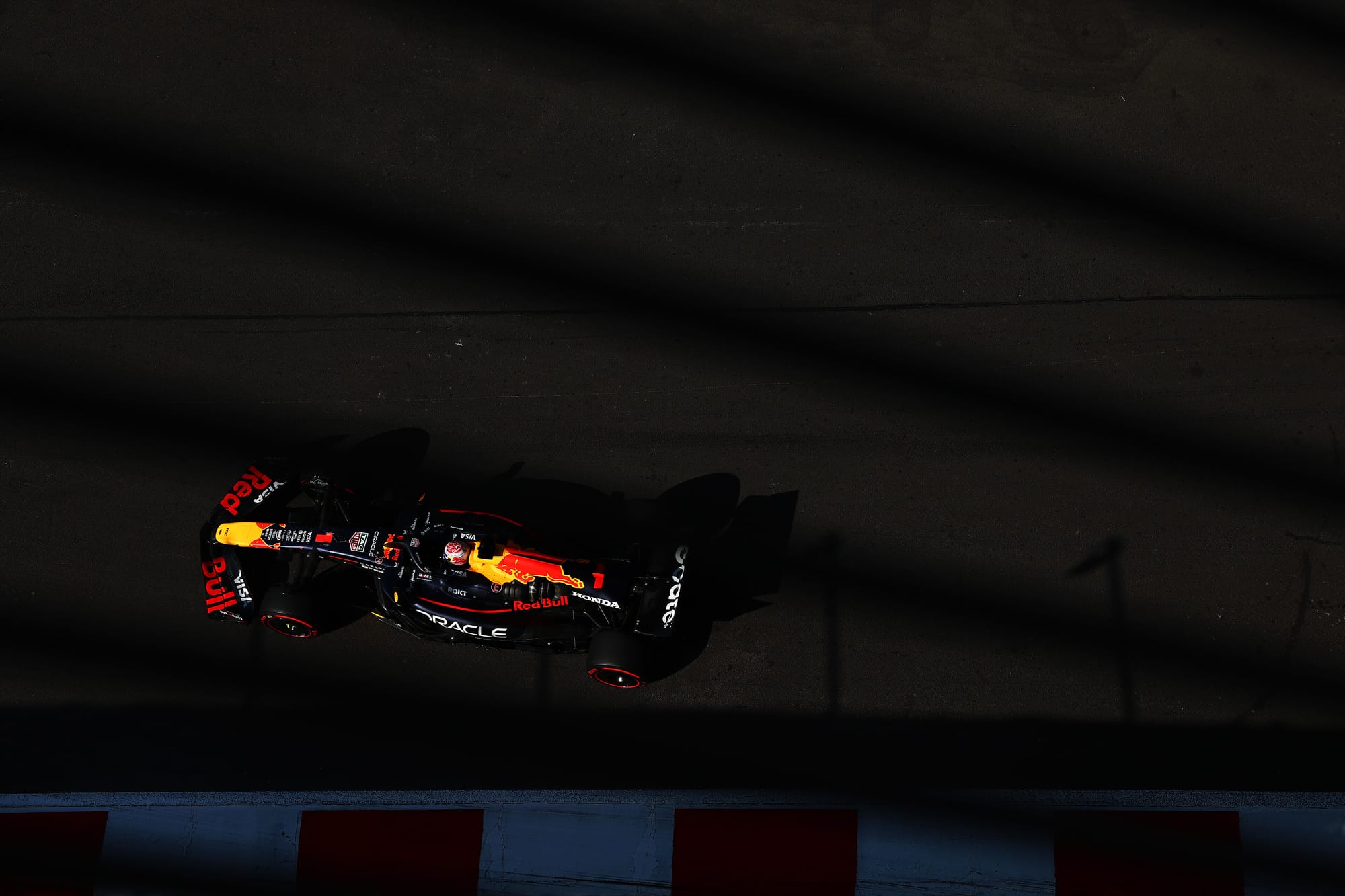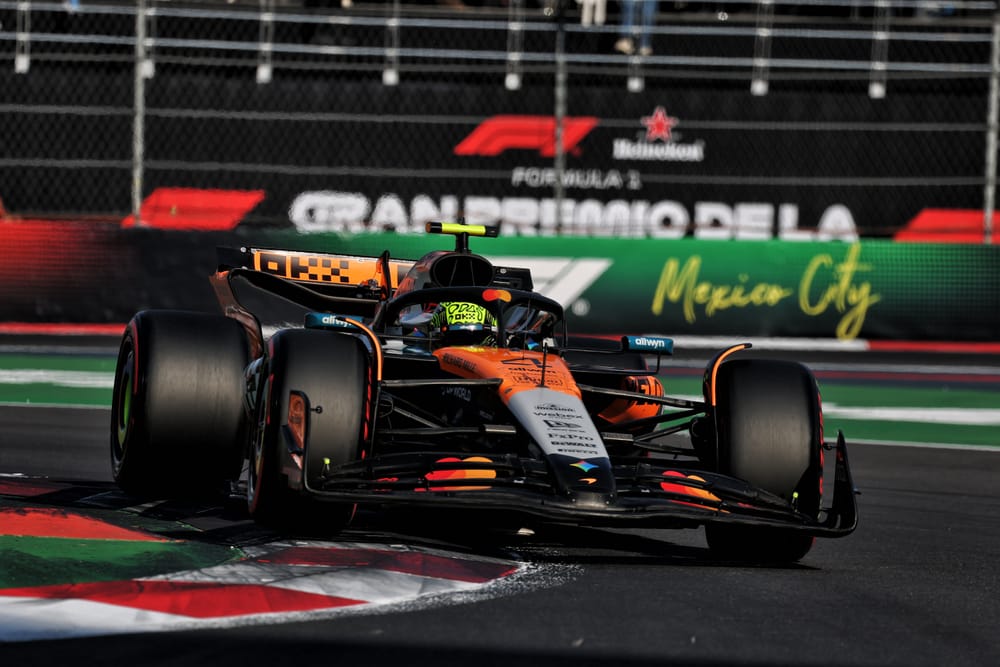As we highlighted here on Friday night, the competitive picture was always going to be volatile around the Mexico City track from one day to the next. It always is.
From Max Verstappen being comfortably fastest over a lap and Lando Norris trailing a few tenths and a few places behind on Friday, we saw the inverse in qualifying with a stunning Norris pole lap and Verstappen struggling, almost half-a-second slower, in fifth place.
What lies behind that is the unique set of challenges posed by this high-altitude track. Not so much the cooling, power unit and downforce implications of it - they are all easily simulated now we've been coming here for so long. What cannot be answered in advance are questions around track grip and the implications on tyre behaviour.
On Friday, Verstappen's Red Bull around a single lap on the soft tyres had an aggressively responsive front end. It was this which gave him his biggest advantage over Norris, particularly through the interconnected Turns 4-5.
The McLaren's front end is not as intrinsically as strong as the Red Bull's, but what it does have is fantastic control of rear tyre temperatures. This would be put to good use overnight in tuning a more responsive balance into the McLaren, one which would not necessarily hurt its advantage shown in the long runs of Friday.
In those multiple lap runs Verstappen had found that the car which was so nicely balanced over a qualifying lap was killing its rear tyres over a race simulation. There was no way they were going to be able to take such a balance into the race.
So significant overnight changes were made to both cars. Red Bull sacrificed some front end response so as not to feed such sudden moments and loads into the rear tyres. McLaren meanwhile decided to lean into its confidence in how good its rear tyre temperature control would be by putting the car a little bit more on the nose - which would hopefully pay it back in qualifying. That's how it played out as Norris took pole by the margin of 0.262 seconds.
Verstappen complained that there was just no grip throughout qualifying while Norris delighted in a car which gave him all the sensations he needs to get to his special place. "It was similar to my lap in Monaco," he explained. "It's not often that I get that feeling in this car. Even though it's incredibly quick, it’s not always easy...like in Singapore, I had nothing like the feeling for the front of the car I had here and no confidence to do what I did."
With the car giving him all the cues he needed, and having been pipped to fastest time in the first Q3 runs by Charles Leclerc's Ferrari, he stepped it up for the final run.
"I just pushed the braking and took a few more risks through the high speed," Norris said. "I was hoping to get ahead of Charles, thought I might do a 1m15.9s or a 1m15.8s, but when I looked at my dash and saw a 1m15.5s I couldn't believe it. I don't know what happened and quite often they are my best laps. The less I know, the better I go."
So, what was it about the respective traits of the Red Bull and McLaren which allowed one to find such a window of perfection which remained resolutely closed for the other?
Verstappen's race engineer Gianpiero Lambiase made a good summary of the difficulties they were facing on Friday evening, saying: "The challenge we are working on at the moment is really trying to find that combination of tyre inner and surface temperature...over one lap both [Red Bulls] were able to put in quite a competitive laptime as you saw in FP2, particularly with Max. So it's the high fuel run pace we are really having to focus all of our attention on.
"We feel we are not really in a happy place with our tyre deg and thermal control of the tyre. We need to get that where we need and want it to be."

The stiffer construction of the 2025 front Pirelli tyre has made this generically more difficult this year but it’s a particularly formidable challenge around this track. Much more so than anywhere else.
When you do a new tyre qualifying lap, the internal tyre temps have not stabilised. That typically takes five-six laps. You are deriving the grip much more from the fresh surface of the tyre and you're essentially abusing the tyre because the core is still quite rigid and so not bending much - lending the surface less help.
The elasticity of the core as it bends to oppose the force gives the tread less work to do. But it doesn't become fully elastic until it's been warmed by the loads being fed into it over a period of laps. If you continued with this tyre after a qualifying lap, by the time the core was up to temperature you'd have overheated the surface and it would be slow.
What Verstappen had on Friday was a front end which really induced a lot of grip from the surface of the front tyres. In doing that he was imposing high peak moments and loads on the rears - before they had got the required internal temperature. Hence they were slow on a long run with that set-up. But very quick over a lap.
Into FP3 with a less front-endy car to try to help the rears, neither front not rear were building up enough grip from their surface to begin really manipulating the core. Because it's such a smooth, gripless surface, and the downforce loads are so low (because of the thin air), that window between too much and not enough is tiny.
The tread temperature needs to be in harmony with the tyre's core temperature. If the loads generated by the tread do not put enough movement in it, the tyre's inner core will remain too cool and inflexible. If the construction itself is not flexible enough, it forces the tread to take up more of the load - causing it then to overheat. Which in turn reduces grip further, a vicious circle of degrading grip.
On a smooth surface the loads are relatively low frequency. So the core isn't getting much help. A slowly heating core and a fast-heating surface means there's only a limited amount of time to get the tread to feed in adequate loads to the core to bring it up to temperature - after which the tread is too hot to do that. The smoother the surface, the smaller that window and if you miss the window, that's it.
That window is either small or closed on the Red Bull, just in its dynamics. The McLaren has a much more flexible performance even if not the ultimate in every department. The key strength is temperature control - of its tyres, brakes and bodywork. That is absolutely gold dust here. Needing to run far smaller cooling louvres than any other car, its aerodynamics are far less compromised by the thin air. But even better than that, its rear tyre temperature control has given it the flexibility to have a good balance in qualifying too.
There's also something in the way the rear suspension still seems to offer a degree of compliance despite being run super-stiff. The downforce increases exponentially the lower these cars can be run and the Red Bull was clearly taking full advantage of the smoothness of the track in running as low as possible, maybe even as low as the McLaren.
But there's a bump on the exit of Turn 9 which consistently upset the RB21 but which didn't much disturb the McLaren. It wasn't the 0.5s difference between the two cars but it was a little telltale of their differing compliance - and the car with more compliance will treat its tyres better. All other things being equal.
But it still needs to be driven hard around the low-grip track, with the car forever sliding and the driver needing to improvise his way to a laptime. It left championship leader Oscar Piastri struggling for the second weekend in succession, 0.6s adrift of Norris and only eighth quickest.
"Here and in Austin, the car slides a lot," explains Andrea Stella, "and that requires a familiarity with how to exploit the car and this is something Oscar still needs to work on a little bit. When in the race the tyres are old and the car slides a lot, this is Lando's regime. Qualifying here is similar to that regime. Oscar is a driver who exploits big grip and drives in a certain way."
Between Norris and Piastri are the two Ferraris, Leclerc just under a tenth ahead of Lewis Hamilton.
The smooth track clearly puts the car in a favourable part of its aero map - one which has been out of bounds for much of the season because of the plank wear issue. It's also a nicely compliant car mechanically. Leclerc squeezed a fabulous lap from it and the fact that Hamilton is close underlines his recent progress.
The Ferrari was a couple of tenths faster than Verstappen's Red Bull and separated from it by George Russell's Mercedes in fifth, with Kimi Antonelli just behind them. Carlos Sainz delivered a fabulous lap in the Williams to pip Piastri but is taking a five-place grid penalty for his Austin incident with Antonelli so starts 12th.



